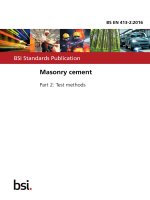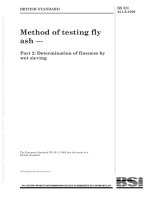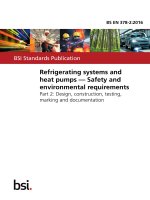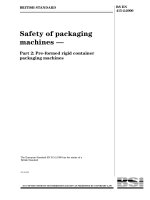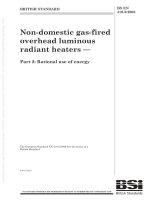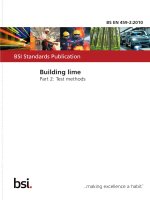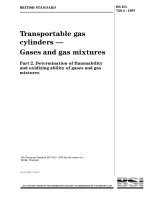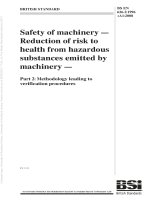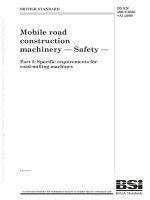Bsi bs en 62320 2 2017
Bạn đang xem bản rút gọn của tài liệu. Xem và tải ngay bản đầy đủ của tài liệu tại đây (3.95 MB, 120 trang )
BS EN 62320-2:2017
BSI Standards Publication
Maritime navigation and
radiocommunication equipment
and systems — Automatic
identification system (AIS)
Part 2: AIS AtoN Stations — Operational
and performance requirements, methods
of testing and required test results
BRITISH STANDARD
BS EN 62320-2:2017
National foreword
This British Standard is the UK implementation of EN 62320-2:2017. It is
identical to IEC 62320-2:2016. It supersedes BS EN 62320-2:2008 which will
be withdrawn on 5 December 2019.
The UK participation in its preparation was entrusted to Technical
Committee EPL/80, Maritime navigation and radiocommunication
equipment and systems.
A list of organizations represented on this committee can be obtained on
request to its secretary.
This publication does not purport to include all the necessary provisions of
a contract. Users are responsible for its correct application.
© The British Standards Institution 2017.
Published by BSI Standards Limited 2017
ISBN 978 0 580 88383 5
ICS 47.020.70
Compliance with a British Standard cannot confer immunity from
legal obligations.
This British Standard was published under the authority of the
Standards Policy and Strategy Committee on 28 February 2017.
Amendments/corrigenda issued since publication
Date
Text affected
BS EN 62320-2:2017
EUROPEAN STANDARD
EN 62320-2
NORME EUROPÉENNE
EUROPÄISCHE NORM
January 2017
ICS 47.020.70
Supersedes EN 62320-2:2008
English Version
Maritime navigation and radiocommunication equipment and
systems - Automatic identification system (AIS) Part 2: AIS AtoN Stations - Operational and performance
requirements, methods of testing and required test results
(IEC 62320-2:2016)
Equipements et systèmes de navigation et de
radiocommunication maritimes - Systèmes d'identification
automatique (AIS) - Partie 2: Stations AIS AtoN Exigences
minimales opérationnelles et de performance, méthodes de
mesure et résultats de test minimum attendus
(IEC 62320-2:2016)
Navigations- und Funkkommunikationsgeräte und -systeme
für die Seeschifffahrt - Automatische Identifikationssysteme
(AIS) - Teil 2: AIS-AtoN-Stationen - Betriebs- und
Leistungsanforderungen, Prüfverfahren und geforderte
Prüfergebnisse
(IEC 62320-2:2016)
This European Standard was approved by CENELEC on 2016-12-05. CENELEC members are bound to comply with the CEN/CENELEC
Internal Regulations which stipulate the conditions for giving this European Standard the status of a national standard without any alteration.
Up-to-date lists and bibliographical references concerning such national standards may be obtained on application to the CEN-CENELEC
Management Centre or to any CENELEC member.
This European Standard exists in three official versions (English, French, German). A version in any other language made by translation
under the responsibility of a CENELEC member into its own language and notified to the CEN-CENELEC Management Centre has the
same status as the official versions.
CENELEC members are the national electrotechnical committees of Austria, Belgium, Bulgaria, Croatia, Cyprus, the Czech Republic,
Denmark, Estonia, Finland, Former Yugoslav Republic of Macedonia, France, Germany, Greece, Hungary, Iceland, Ireland, Italy, Latvia,
Lithuania, Luxembourg, Malta, the Netherlands, Norway, Poland, Portugal, Romania, Serbia, Slovakia, Slovenia, Spain, Sweden,
Switzerland, Turkey and the United Kingdom.
European Committee for Electrotechnical Standardization
Comité Européen de Normalisation Electrotechnique
Europäisches Komitee für Elektrotechnische Normung
CEN-CENELEC Management Centre: Avenue Marnix 17, B-1000 Brussels
© 2017 CENELEC All rights of exploitation in any form and by any means reserved worldwide for CENELEC Members.
Ref. No. EN 62320-2:2017 E
BS EN 62320-2:2017
EN 62320-2:2017
European foreword
The text of document 80/817/FDIS, future edition 2 of IEC 62320-2, prepared by IEC/TC 80 "Maritime
navigation and radiocommunication equipment and systems" was submitted to the IEC-CENELEC
parallel vote and approved by CENELEC as EN 62320-2:2017.
The following dates are fixed:
•
latest date by which the document has to be
implemented at national level by
publication of an identical national
standard or by endorsement
(dop)
2017-09-05
•
latest date by which the national
standards conflicting with the
document have to be withdrawn
(dow)
2019-12-05
This document supersedes EN 62320-2:2008.
Attention is drawn to the possibility that some of the elements of this document may be the subject of
patent rights. CENELEC [and/or CEN] shall not be held responsible for identifying any or all such
patent rights.
Endorsement notice
The text of the International Standard IEC 62320-2:2016 was approved by CENELEC as a European
Standard without any modification.
In the official version, for Bibliography, the following notes have to be added for the standards indicated:
2
IEC 61162-1
NOTE
Harmonized as EN 61162-1.
IEC 61162-2
NOTE
Harmonized as EN 61162-2.
IEC 61162-460
NOTE
Harmonized as EN 61162-460.
IEC 61993-2
NOTE
Harmonized as EN 61993-2.
BS EN 62320-2:2017
EN 62320-2:2017
Annex ZA
(normative)
Normative references to international publications
with their corresponding European publications
The following documents, in whole or in part, are normatively referenced in this document and are
indispensable for its application. For dated references, only the edition cited applies. For undated
references, the latest edition of the referenced document (including any amendments) applies.
NOTE 1 When an International Publication has been modified by common modifications, indicated by (mod), the relevant
EN/HD applies.
NOTE 2 Up-to-date information on the latest versions of the European Standards listed in this annex is available here:
www.cenelec.eu
Publication
Year
Title
EN/HD
IEC 60945
-
Maritime navigation and
EN 60945
radiocommunication equipment and
systems - General requirements - Methods
of testing and required test results
-
IEC 61108
Series
Maritime navigation and
radiocommunication equipment and
systems - Global navigation satellite
systems (GNSS)
Series
IEC 62287-1
-
Maritime navigation and
EN 62287-1
radiocommunication equipment and
systems - Class B shipborne equipment of
the automatic identification system (AIS) Part 1: Carrier-sense time division multiple
access (CSTDMA) techniques
-
IEC 62320-3
2015
Maritime navigation and
EN 62320-3
radiocommunication equipment and
systems - Automatic identification systems
(AIS) - Part 3: AIS Simplex Repeater
Station - Minimum operational and
performance requirements, methods of
testing and required test results
2015
ITU Radio
Regulations,
Appendix 18
-
Table of transmitting frequencies in the
VHF maritime mobile band
-
-
ITU-R
Recommendation
M.1371-5
2014
Technical characteristics for an automatic identification system using time-division
multiple access in the VHF maritime mobile
band
-
IALA
Recommendation
A-126
-
The use of Automatic Identification
System (AIS) in Marine Aids to Navigation
-
EN 61108
Year
3
–2–
BS EN 62320-2:2017
IEC 62320-2:2016 © IEC 2016
CONTENTS
FOREWORD ........................................................................................................................... 8
1
Scope ............................................................................................................................ 10
2
Normative references .................................................................................................... 10
3
Terms, definitions and abbreviations ............................................................................. 11
3.1
Terms and definitions ............................................................................................ 11
3.2
Abbreviated terms ................................................................................................. 11
4
Description .................................................................................................................... 12
4.1
Types of AIS AtoN stations ................................................................................... 12
4.2
Type 1 AIS AtoN station ........................................................................................ 15
4.2.1
Characteristics............................................................................................... 15
4.2.2
Capability ...................................................................................................... 17
4.2.3
Alternatives ................................................................................................... 17
4.3
Type 2 AIS AtoN station ........................................................................................ 18
4.3.1
Characteristics............................................................................................... 18
4.3.2
Capability ...................................................................................................... 18
4.3.3
Control receiver ............................................................................................. 18
4.3.4
Alternatives ................................................................................................... 18
4.4
Type 3 AIS AtoN Station ....................................................................................... 19
4.4.1
Characteristics............................................................................................... 19
4.4.2
Capability ...................................................................................................... 19
4.4.3
AIS receiver (AIS Rx) .................................................................................... 19
4.4.4
Alternatives ................................................................................................... 19
4.5
Optional direct configuration via VDL (types 2 and 3) ............................................ 20
4.6
Optional configuration via VDL using chaining (type 3) .......................................... 20
5
Requirements for AIS AtoN stations ............................................................................... 23
5.1
5.1.1
5.1.2
5.1.3
5.1.4
5.2
5.2.1
5.2.2
5.2.3
5.2.4
5.2.5
5.2.6
5.2.7
5.3
5.3.1
5.3.2
5.3.3
5.4
5.5
5.5.1
5.5.2
Physical layer ....................................................................................................... 23
Transmitter requirements ............................................................................... 23
Receiver requirements ................................................................................... 25
Power consumption ....................................................................................... 26
Environmental requirements .......................................................................... 26
Link layer .............................................................................................................. 27
General ......................................................................................................... 27
AIS Messages ............................................................................................... 27
Synchronisation ............................................................................................. 27
VDL access schemes..................................................................................... 28
Autonomous mode ......................................................................................... 30
Electronic position fix system ......................................................................... 31
Built-in integrity test ....................................................................................... 32
Configuration method ............................................................................................ 33
General ......................................................................................................... 33
Alternative for types 1, 2 and 3 ...................................................................... 33
Chaining of AIS AtoN stations ........................................................................ 36
Repeat broadcast of active AIS-SART message .................................................... 36
Other requirements ............................................................................................... 36
Additional features ......................................................................................... 36
Manufacturer’s information ............................................................................ 36
BS EN 62320-2:2017
IEC 62320-2:2016 © IEC 2016
6
–3–
5.5.3
Marking and identification .............................................................................. 37
5.5.4
Additional connection points .......................................................................... 37
Tests of AIS AtoN stations ............................................................................................. 37
6.1
General ................................................................................................................. 37
6.2
Test conditions ..................................................................................................... 37
6.2.1
Normal test conditions ................................................................................... 37
6.2.2
Extreme test conditions ................................................................................. 37
6.2.3
Standard test environment ............................................................................. 38
6.2.4
Test signals ................................................................................................... 38
6.2.5
Arrangements for test signals applied to the receiver input ............................ 39
6.2.6
Encoder for receiver measurements .............................................................. 40
6.2.7
Waiver for receivers ....................................................................................... 40
6.2.8
Impedance ..................................................................................................... 40
6.2.9
Artificial antenna (dummy load) ..................................................................... 40
6.2.10
Facilities for access ....................................................................................... 40
6.2.11
Modes of operation of the transmitter............................................................. 40
6.2.12
Measurement uncertainties ............................................................................ 40
7
RF tests ......................................................................................................................... 41
7.1
TDMA transmitter .................................................................................................. 41
7.1.1
General ......................................................................................................... 41
7.1.2
Frequency error ............................................................................................. 41
7.1.3
Carrier power ................................................................................................. 42
7.1.4
Modulation spectrum slotted transmission ...................................................... 42
7.1.5
Transmitter test sequence and modulation accuracy ...................................... 43
7.1.6
Transmitter output power versus time function (FATDMA and RATDMA) ....... 45
7.2
TDMA receivers (types 2 and 3) ............................................................................ 46
7.2.1
Sensitivity ...................................................................................................... 46
7.2.2
Error behaviour at high input levels................................................................ 47
7.2.3
Co-channel rejection ...................................................................................... 47
7.2.4
Adjacent channel selectivity ........................................................................... 48
7.2.5
Spurious response rejection .......................................................................... 49
7.2.6
Inter-modulation response rejection ............................................................... 52
7.2.7
Blocking or desensitization ............................................................................ 53
7.3
Conducted spurious emissions at the antenna ...................................................... 54
7.3.1
Spurious emissions from the receiver ............................................................ 54
7.3.2
Spurious emissions from the transmitter ........................................................ 54
8
Functional tests ............................................................................................................. 55
8.1
Configuration method ............................................................................................ 55
8.1.1
General ......................................................................................................... 55
8.1.2
Configuration for Message 21 ........................................................................ 55
8.1.3
Schedule mode A FATDMA Message 21 (single report, alternating
channel operation) ......................................................................................... 56
8.1.4
Schedule mode B FATDMA Message 21 (dual report, dual channel
operation) ...................................................................................................... 57
8.1.5
Schedule mode C FATDMA Message 21 (single report, single channel
operation) ...................................................................................................... 57
8.1.6
Schedule mode A RATDMA Message 21 (Type 3) (single report,
alternating channel operation) ....................................................................... 58
8.1.7
Schedule mode B RATDMA Message 21 (Type 3) (dual report, dual
channel operation) ......................................................................................... 59
–4–
8.1.8
BS EN 62320-2:2017
IEC 62320-2:2016 © IEC 2016
Schedule mode C RATDMA Message 21 (type 3) (single channel
operation) ...................................................................................................... 59
8.1.9
Scheduled transmission of Message 6 ........................................................... 60
8.1.10
Scheduled transmission of Message 8 ........................................................... 61
8.1.11
Scheduled transmission of Message 12 ......................................................... 61
8.1.12
Scheduled transmission of Message 14 ......................................................... 61
8.1.13
Unscheduled transmission ............................................................................. 62
8.2
Synchronisation accuracy ..................................................................................... 62
8.2.1
Implemented synchronisation modes and synchronisation error ..................... 62
8.2.2
Synchronisation test without UTC (types 2 and 3) .......................................... 63
8.3
EPFS .................................................................................................................... 64
8.3.1
Position source .............................................................................................. 64
8.3.2
Invalid position .............................................................................................. 64
8.3.3
Off-position monitor ....................................................................................... 64
8.4
Receive addressed message (types 2 and 3) ........................................................ 65
8.4.1
Purpose ......................................................................................................... 65
8.4.2
Method of measurement ................................................................................ 65
8.4.3
Required results ............................................................................................ 65
8.5
Interrogation response (Type 3) ............................................................................ 65
8.5.1
Purpose ......................................................................................................... 65
8.5.2
Method of measurement ................................................................................ 65
8.5.3
Required results ............................................................................................ 66
8.6
Repeat AIS-SART messages ................................................................................ 66
8.6.1
Purpose ......................................................................................................... 66
8.6.2
Method of measurement ................................................................................ 66
8.6.3
Required results ............................................................................................ 66
8.7
Additional functionality as implemented by the manufacturer................................. 66
8.7.1
Test for configuration of the receiver turn-on times (types 2 and 3) ................ 66
8.7.2
Test for configuration of payload transmission ............................................... 67
8.7.3
Test for forced broadcast ............................................................................... 68
8.7.4
Test for version information ........................................................................... 68
8.7.5
Test for DCR – AtoN function ID capability .................................................... 69
8.7.6
Test for assigning an encryption key for VDL configuration ............................ 69
8.7.7
Test for VDL configuration using chaining (Type 3) ........................................ 70
8.8
BIIT....................................................................................................................... 75
8.8.1
Purpose ......................................................................................................... 75
8.8.2
Method of measurement ................................................................................ 75
8.8.3
Required results ............................................................................................ 75
8.9
Transmitter shutdown procedure ........................................................................... 75
8.9.1
Purpose ......................................................................................................... 75
8.9.2
Method of measurement ................................................................................ 75
8.9.3
Required results ............................................................................................ 75
8.10 Power supply ........................................................................................................ 75
8.10.1
Purpose ......................................................................................................... 75
8.10.2
Method of measurement ................................................................................ 76
8.10.3
Required results ............................................................................................ 76
8.11 Environmental ....................................................................................................... 76
8.12 External removable media ..................................................................................... 76
8.12.1
Purpose ......................................................................................................... 76
BS EN 62320-2:2017
IEC 62320-2:2016 © IEC 2016
–5–
8.12.2
Method of measurement ................................................................................ 76
8.12.3
Required results ............................................................................................ 76
8.13 Other tests ............................................................................................................ 76
8.13.1
Quality assurance .......................................................................................... 76
8.13.2
Additional features ......................................................................................... 76
8.13.3
Manual .......................................................................................................... 77
8.13.4
Marking and identification .............................................................................. 77
8.14 Optional TAG block encapsulation ........................................................................ 77
8.14.1
Application ..................................................................................................... 77
8.14.2
TAG block capabilities ................................................................................... 77
8.14.3
Activation of source-identification for output .................................................. 77
8.14.4
Activation of Destination-identification ........................................................... 78
8.14.5
Activation of Source-identification for input .................................................... 79
8.14.6
Use of multiple source-identifications for input ............................................... 80
8.14.7
Test of grouping by TAG blocks for output ..................................................... 81
8.14.8
Test of UNIX time output ............................................................................... 82
8.14.9
Test of line-count output ................................................................................ 82
Annex A (informative) AIS AtoN station configuration structures .......................................... 84
A.1
A.2
A.3
A.4
A.5
A.6
A.7
A.8
A.9
A.10
A.11
A.12
A.13
A.14
A.15
A.16
Annex B
AIS AtoN station configuration structures .............................................................. 84
MMSI Identification configuration command (AID) ................................................. 87
Extended/general AtoN station configuration command (ACF/ACG) ...................... 89
Configure broadcast rates for AtoN Station message command (CBR) .................. 94
Configuration of encryption key (CEK) .................................................................. 97
Configure the receiver turn-on times (ARW) .......................................................... 98
Proprietary AtoN control command (MCR)............................................................. 99
Configuration of message payload for broadcast (MEB) ...................................... 101
Forced broadcast command (AFB) ...................................................................... 101
Version information (VER) .................................................................................. 102
AtoN function ID capability .................................................................................. 104
Query via the VDL for Message 21 content ......................................................... 105
General query request ........................................................................................ 106
Configuration of receiver operational times command (COP) .............................. 107
Configuration of message payload for broadcast (MEB) ...................................... 108
Query response via the VDL for Message 21 configuration ................................. 110
(normative) Message 21 – AtoN status bits .......................................................... 113
Bibliography ........................................................................................................................ 114
Figure 1 – Functional block diagram of a Type 1 AIS AtoN Station ........................................ 16
Figure 2 – Functional block diagram of a type 2 AIS AtoN station ......................................... 18
Figure 3 – Functional block diagram of a type 3 AIS AtoN station ......................................... 19
Figure 4 – VDL configuration decision tree ............................................................................ 22
Figure 5 – Power versus time mask ...................................................................................... 29
Figure 6 – Reporting modes for Message 21 ......................................................................... 31
Figure 7 – Block diagram of AIS AtoN test setup ................................................................... 38
Figure 8 – Format for repeating four-packet cluster ............................................................... 39
Figure 9 – Measurement arrangement for frequency error ..................................................... 41
Figure 10 – Measurement arrangement for carrier power ...................................................... 42
–6–
BS EN 62320-2:2017
IEC 62320-2:2016 © IEC 2016
Figure 11 – Emission mask ................................................................................................... 43
Figure 12 – Measurement arrangement for modulation accuracy ........................................... 44
Figure 13 – Measurement arrangement for sensitivity ........................................................... 46
Figure 14 – Measurement arrangement for error behaviour ................................................... 47
Figure 15 – Measurement arrangement for co-channel rejection ........................................... 48
Figure 16 – Measurement arrangement for adjacent channel selectivity ................................ 49
Figure 17 – PER/BER or SINAD measuring equipment ......................................................... 50
Figure 18 – Measurement arrangement for inter-modulation ................................................. 52
Figure 19 – Measurement arrangement for blocking or desensitisation ................................. 53
Figure 20 – Test scenario for basic chaining test .................................................................. 70
Figure 21 – Test scenario for linear chaining test .................................................................. 72
Figure 22 – Test scenario for forked chaining test ................................................................. 73
Figure B.1 – Use of AtoN status bits as IALA A-126 Page ID 7 ........................................... 113
Table 1 – Description of AIS AtoN stations ............................................................................ 13
Table 2 – Use of VDL messages ........................................................................................... 14
Table 3 – Summary of optional Type 1 AIS AtoN Station messages ...................................... 17
Table 4 – Summary of optional Type 3 AIS AtoN Station messages ...................................... 20
Table 5 – Configuration of AIS AtoN stations via VDL ........................................................... 23
Table 6 – Required parameter settings for an AIS AtoN Station ............................................ 24
Table 7 – Required settings of physical layer constants ........................................................ 24
Table 8 – Modulation parameters of the physical layer of the AIS AtoN station ..................... 24
Table 9 – Minimum required TDMA transmitter characteristics .............................................. 25
Table 10 – Required receiver characteristics ........................................................................ 26
Table 11 – Maximum allowed time error ................................................................................ 28
Table 12 – Definitions of timing for Figure 5 .......................................................................... 30
Table 13 – AIS AtoN Station reaction to BIIT conditions ........................................................ 33
Table 14 – Standard sentences ............................................................................................. 34
Table 15 – DCR Capabilities ................................................................................................. 35
Table 16 – Optional TAG Block functions .............................................................................. 36
Table 17 – Content of first two packets ................................................................................. 39
Table 18 – Fixed PRS data derived from ITU-T O.153........................................................... 39
Table 19 – Maximum values of absolute measurement uncertainties ..................................... 41
Table 20 – Peak frequency deviation versus time.................................................................. 45
Table 21 – Definition of timings ............................................................................................. 45
Table 22 – Frequencies for inter-modulation test .................................................................. 53
Table A.1 – Parameter setting in Message 25 for AIS AtoN Station applications ................... 84
Table A.2 – Parameter setting in Message 6 for AIS AtoN Station applications ..................... 85
Table A.3 – Message 25 or 6 function identifier used for configuration and query via
the VDL ................................................................................................................................ 86
Table A.4 – Configuration via the VDL for MMSI identification ............................................... 88
Table A.5 – Query via the VDL for MMSI identification .......................................................... 88
Table A.6 – Query response via the VDL for MMSI identification ........................................... 89
BS EN 62320-2:2017
IEC 62320-2:2016 © IEC 2016
–7–
Table A.7 – Configuration via the VDL, Part 1 ....................................................................... 90
Table A.8 – Configuration via the VDL, Part 2 ....................................................................... 90
Table A.9 – Configuration via the VDL, Part 3 ....................................................................... 91
Table A.10 – Configuration via the VDL, Part 4 (first 12 characters of AtoN name)................ 91
Table A.11 – Configuration via the VDL, Part 5 (second 12 characters of AtoN name) .......... 92
Table A.12 – Configuration via the VDL, Part 6 (third (last) 10 characters of AtoN
name) ................................................................................................................................... 92
Table A.13 – Query request via the VDL ............................................................................... 92
Table A.14 – Query response via the VDL, Part 1 ................................................................. 93
Table A.15 – Query response via the VDL, Part 2 ................................................................. 94
Table A.16 – Configuration via the VDL for FATDMA ............................................................ 95
Table A.17 – Configuration via the VDL for RATDMA/CSTDMA ............................................. 96
Table A.18 – Query request via the VDL for AtoN broadcast rates ........................................ 96
Table A.19 – Query response via the VDL with AtoN broadcast rates .................................... 97
Table A.20 – Configuration via the VDL of encryption key ..................................................... 98
Table A.21 – Configuration via the VDL for receiver turn-on times ........................................ 98
Table A.22 – Query request via the VDL for receiver turn-on times ....................................... 99
Table A.23 – Query response via the VDL for receiver turn-on times..................................... 99
Table A.24 – Configuration via the VDL for proprietary information ..................................... 100
Table A.25 – Query request via the VDL for proprietary information .................................... 100
Table A.26 – Query response via the VDL for proprietary information ................................. 100
Table A.27 – Configuration or function via the VDL of message payload ............................. 101
Table A.28 – Function via the VDL for forced broadcast ...................................................... 102
Table A.29 – Query request via the VDL for VER ................................................................ 103
Table A.30 – Query response via the VDL for VER ............................................................. 104
Table A.31 – Query request via the VDL for function ID ...................................................... 104
Table A.32 – Query response via the VDL for function ID .................................................... 105
Table A.33 – Query request via the VDL for Message 21 content ........................................ 106
Table A.34 – Query response via the VDL for Message 21 content ..................................... 106
Table A.35 – General query request via the VDL ................................................................ 107
Table A.36 – Configuration via the VDL for COP ................................................................. 108
Table A.37 – Payload control configuration via the VDL ...................................................... 109
Table A.38 – Payload binary data via the VDL .................................................................... 110
Table A.39 – Query response via the VDL, Message 21 configuration ................................. 111
Table A.40 – Query response via the VDL, first 12 characters of AtoN name ...................... 111
Table A.41 – Query response via the VDL, second 12 characters of AtoN name ................. 112
Table A.42 – Query response via the VDL, last 10 characters of AtoN name ....................... 112
Table B.1 – AtoN status pages ............................................................................................ 113
–8–
BS EN 62320-2:2017
IEC 62320-2:2016 © IEC 2016
INTERNATIONAL ELECTROTECHNICAL COMMISSION
____________
MARITIME NAVIGATION AND RADIOCOMMUNICATION EQUIPMENT
AND SYSTEMS – AUTOMATIC IDENTIFICATION SYSTEM (AIS) –
Part 2: AIS AtoN Stations – Operational and performance
requirements, methods of testing and required test results
FOREWORD
1) The International Electrotechnical Commission (IEC) is a worldwide organization for standardization comprising
all national electrotechnical committees (IEC National Committees). The object of IEC is to promote
international co-operation on all questions concerning standardization in the electrical and electronic fields. To
this end and in addition to other activities, IEC publishes International Standards, Technical Specifications,
Technical Reports, Publicly Available Specifications (PAS) and Guides (hereafter referred to as “IEC
Publication(s)”). Their preparation is entrusted to technical committees; any IEC National Committee interested
in the subject dealt with may participate in this preparatory work. International, governmental and nongovernmental organizations liaising with the IEC also participate in this preparation. IEC collaborates closely
with the International Organization for Standardization (ISO) in accordance with conditions determined by
agreement between the two organizations.
2) The formal decisions or agreements of IEC on technical matters express, as nearly as possible, an international
consensus of opinion on the relevant subjects since each technical committee has representation from all
interested IEC National Committees.
3) IEC Publications have the form of recommendations for international use and are accepted by IEC National
Committees in that sense. While all reasonable efforts are made to ensure that the technical content of IEC
Publications is accurate, IEC cannot be held responsible for the way in which they are used or for any
misinterpretation by any end user.
4) In order to promote international uniformity, IEC National Committees undertake to apply IEC Publications
transparently to the maximum extent possible in their national and regional publications. Any divergence
between any IEC Publication and the corresponding national or regional publication shall be clearly indicated in
the latter.
5) IEC itself does not provide any attestation of conformity. Independent certification bodies provide conformity
assessment services and, in some areas, access to IEC marks of conformity. IEC is not responsible for any
services carried out by independent certification bodies.
6) All users should ensure that they have the latest edition of this publication.
7) No liability shall attach to IEC or its directors, employees, servants or agents including individual experts and
members of its technical committees and IEC National Committees for any personal injury, property damage or
other damage of any nature whatsoever, whether direct or indirect, or for costs (including legal fees) and
expenses arising out of the publication, use of, or reliance upon, this IEC Publication or any other IEC
Publications.
8) Attention is drawn to the Normative references cited in this publication. Use of the referenced publications is
indispensable for the correct application of this publication.
9) Attention is drawn to the possibility that some of the elements of this IEC Publication may be the subject of
patent rights. IEC shall not be held responsible for identifying any or all such patent rights.
International Standard IEC 62320-2 has been prepared by IEC technical committee 80:
Maritime navigation and radiocommunication equipment and systems.
This second edition cancels and replaces the first edition, published in 2008, and constitutes
a technical revision.
This edition includes the following significant technical changes with respect to the previous
edition:
•
additional cyber security measures;
•
updated description of configuration via VDL;
•
updated VDL access scheme requirements;
•
new PI sentences and VDL message structures with added description for optional TAG
blocks;
BS EN 62320-2:2017
IEC 62320-2:2016 â IEC 2016
9
ã
added requirement for at least one standard method for configuration using Standard PI
sentences;
•
updated test methods and updated Annexes.
The text of this standard is based on the following documents:
FDIS
Report on voting
80/817/FDIS
80/822/RVD
Full information on the voting for the approval of this standard can be found in the report on
voting indicated in the above table.
This publication has been drafted in accordance with the ISO/IEC Directives, Part 2.
A list of all parts in the IEC 62320 series, published under the general title Maritime
navigation and radiocommunication equipment and systems – Automatic identification system
(AIS), can be found on the IEC website.
The committee has decided that the contents of this publication will remain unchanged until
the stability date indicated on the IEC web site under "" in the data
related to the specific publication. At this date, the publication will be
•
reconfirmed,
•
withdrawn,
•
replaced by a revised edition, or
•
amended.
A bilingual version of this publication may be issued at a later date.
IMPORTANT – The 'colour inside' logo on the cover page of this publication indicates
that it contains colours which are considered to be useful for the correct
understanding of its contents. Users should therefore print this document using a
colour printer.
– 10 –
BS EN 62320-2:2017
IEC 62320-2:2016 © IEC 2016
MARITIME NAVIGATION AND RADIOCOMMUNICATION EQUIPMENT
AND SYSTEMS – AUTOMATIC IDENTIFICATION SYSTEM (AIS) –
Part 2: AIS AtoN Stations – Operational and performance
requirements, methods of testing and required test results
1
Scope
This part of IEC 62320 specifies the operational and performance requirements, methods of
testing and required test results for AIS AtoN Stations compatible with the performance
standards adopted by IMO Resolution MSC.74(69), Annex 3, Universal AIS. It incorporates
the technical characteristics of non-shipborne AIS AtoN equipment, included in
Recommendation ITU-R M.1371 and IALA Recommendation A-126. Where applicable, it also
takes into account the ITU Radio Regulations. This standard takes into account other
associated IEC International Standards and existing national standards, as applicable.
This document is applicable for automatic identification system (AIS) installations on aids to
navigation (AtoN).
2
Normative references
The following referenced documents are indispensable for the application of this document.
For dated references, only the edition cited applies. For undated references, the latest edition
of the referenced document (including any amendments) applies.
IEC 60945, Maritime navigation and radiocommunication equipment and systems – General
requirements – Methods of testing and required test results
IEC 61108 (all parts), Maritime navigation and radiocommunication equipment and systems –
Global navigation satellite systems (GNSS)
IEC 62287-1, Maritime navigation and radiocommunication equipment and systems – Class B
shipborne equipment of the automatic identification system (AIS) – Part 1: Carrier-sense time
division multiple access (CSTDMA) techniques
IEC 62320-3:2015, Maritime navigation and radiocommunication equipment and systems –
Automatic identification systems (AIS) – Part 3: Repeater station – Minimum operational and
performance requirements – Methods of test and required test results
ITU Radio Regulations, Appendix 18, Table of transmitting frequencies in the VHF maritime
mobile band
ITU-R Recommendation M.1371-5:2014, Technical characteristics for an automatic
identification system using time division multiple access in the VHF maritime mobile band
IALA Recommendation A-126, The Use of Automatic Identification System (AIS) in Marine
Aids to Navigation
BS EN 62320-2:2017
IEC 62320-2:2016 © IEC 2016
3
– 11 –
Terms, definitions and abbreviations
3.1
Terms and definitions
For the purposes of this document, the following terms and definitions apply.
3.1.1
aids to navigation
AtoN
device or system external to vessels that is designed and operated to enhance the safe and
efficient navigation of vessels and/or vessel traffic
3.1.2
Message 21
AtoN report transmitted on the VHF data link by an AIS station
3.1.3
real AIS AtoN
AIS AtoN station which is physically located on the aid to navigation
Note 1 to entry: IMO MSC.1/Circ.1473 states that physical AIS AtoN is an AIS Message 21 representing an aid to
navigation that physically exists.
3.1.4
synthetic AIS AtoN
Message 21 transmitted from an AIS station located remotely from the aid to navigation
Note 1 to entry: IMO MSC.1/Circ.1473 states that physical AIS AtoN is an AIS Message 21 representing an aid to
navigation that physically exists.
3.1.5
virtual AIS AtoN
Message 21 transmitted from an AIS station for an aid to navigation which does not physically
exist
3.2
Abbreviated terms
AES
Advanced Encryption Standard
AIS
automatic identification system
BIIT
built-in integrity test
BT
bandwidth-time product
CSTDMA
carrier sense time division multiple access
DGNSS
differential global navigation satellite system
EPFS
electronic position fixing system
EUT
equipment under test
FATDMA
fixed access time division multiple access
GNSS
global navigation satellite system
IMO
International Maritime Organization
MMSI
Maritime Mobile Service Identity
NRZI
non-return to zero inverted
PER
packet error rate
PI
presentation interface
RAIM
receiver autonomous integrity monitoring
RATDMA
random access time division multiple access
– 12 –
RF
radio frequency
Rx
receive
SBAS
satellite-based augmentation system
SOTDMA
self-organizing time division multiple access
TDMA
time division multiple access
Tx
transmit
UTC
Coordinated Universal Time
VDL
VHF data link
VHF
very high frequency
VSWR
voltage standing wave ratio
4
4.1
BS EN 62320-2:2017
IEC 62320-2:2016 © IEC 2016
Description
Types of AIS AtoN stations
There are three types of AIS AtoN stations as defined in Table 1. The AIS AtoN stations may
optionally include additional capabilities as defined in the comments column. Table 2
describes the use of the messages.
BS EN 62320-2:2017
IEC 62320-2:2016 © IEC 2016
– 13 –
Table 1 – Description of AIS AtoN stations
Requirements
VDL receiver
Type 1 AIS
AtoN station
Type 2 AIS
AtoN station
Type 3 AIS
AtoN station
Comments
No receiver
Receiver for
query,
configuration, or
control
functions only
Two receiving
processes for
autonomous
mode
(RATDMA)
When RATDMA is not used, only
one receiving process is required
for autonomous mode.
Transmitted
messages
21
See Table 2.
Access mode for
Message 21
FATDMA
FATDMA
FATDMA &
RATDMA
Access Mode for
messages other
than 21, if
implemented
FATDMA
FATDMA
FATDMA &
RATDMA
Configuration /
communication
method
Standard sentences of Table 14
Physical interface defined by manufacturer
CSTDMA (Type 3)
Defined by the manufacturer with
standard sentences and optionally
using TAG Blocks.
Physical
communication
interface
At least one shall be provided by the manufacturer for
test. Not required for operation.
Transmit power
Nominal 12,5 W
As defined by the manufacturer
Transmitter
capability
Frequency agile
Single frequency
Synthetic and
Virtual AtoN
Positioning
device
UTC
synchronisation
Not Required
Yes
EPFS and surveyed position
Surveyed position only (no EPFS)
UTC Direct
UTC indirect or semaphore (Type
3)
Assignment
Shall not respond to assignment Messages 16 and 23
Interrogation
Shall respond with the Message 21 of the Real AIS
AtoN MMSI only.
MMSI = 000000000
No schedule configured
Default (initial
factory setting)
The electrical and physical
characteristics shall be defined by
the manufacturer.
No virtual AtoN configured
Radio parameters configured per Table 6
No surveyed position
Encryption key = all zeros
AtoN status bits = all zeros
BS EN 62320-2:2017
IEC 62320-2:2016 © IEC 2016
– 14 –
Table 2 – Use of VDL messages
Msg.
No.
R/P
R/P
PI
T
T
Type 2
Type 3
Output
Type 1&2
Type 3
Name of message M.1371-5
Ref.
Remark
0
Undefined
None
No
No
No
No
No
Reserved for future
use
1
Position report
(scheduled)
A8-3.1
No
Yes
Yes
No
Opt
Comm State
requires evaluation
if RATDMA enabled
Only implemented to
repeat active AISSART messages
2
Position report
(assigned)
A8-3.1
No
Yes
Yes
No
No
Comm State
requires evaluation
if RATDMA enabled
3
Position report
(when
interrogated)
A8-3.1
No
Yes
Yes
No
No
Comm State
requires evaluation
if RATDMA enabled
4
Base station report A8-3.2
No
Yes
Yes
No
No
Comm State
requires evaluation
if RATDMA enabled
5
Static and voyage
related data
A8-3.3
No
No
Yes
No
No
6
Addressed binary
message
A8-3.4
Opt
Opt
Yes
Opt
Opt
7
Binary
acknowledge
A8-3.5
Opt
Opt
Opt
No
Opt
8
Binary broadcast
message
A8-3.6
No
No
Yes
Opt
Opt
9
Standard SAR
aircraft position
report
A8-3.7
No
Yes
Yes
No
No
10
UTC and date
inquiry
A8-3.8
No
No
Opt
No
No
11
UTC/ date
response
A8-3.9
No
No
Opt
No
No
12
Addressed safety
related message
A8-3.10
No
Opt
Yes
Opt
Opt
13
Safety related
acknowledge
A8-3.11
No
Opt
Opt
No
Opt
14
Safety related
A8-3.12
broadcast message
No
Opt
Yes
Opt
Opt
15
Interrogation
A8-3.13
Opt
Opt
Opt
No
No
16
Assigned mode
command
A8-3.14
No
No
Opt
No
No
17
DGNSS
A8-3.15
No
Opt
Opt
No
No
18
Standard Class B A8-3.16
equipment position
report
No
Yes
Yes
No
No
Only if addressed to
own station
including virtual
MMSIs associated
with own station, or
0
Comm State
requires evaluation
if RATDMA enabled
Only if addressed to
own station
including virtual
MMSIs associated
with own station, or
0
Shall respond with
the Message 21 of
the Real AIS AtoN
MMSI only
Comm State
requires evaluation
if RATDMA enabled
BS EN 62320-2:2017
IEC 62320-2:2016 © IEC 2016
Msg.
No.
– 15 –
R/P
R/P
PI
T
T
Type 2
Type 3
Output
Type 1&2
Type 3
Name of message M.1371-5
Ref.
19
Extended Class B A8-3.17
equipment position
report
No
No
Opt
No
No
20
Data link
management
message
A8-3.18
No
No
Opt
No
No
21
Aids-to-Navigation A8-3.19
report
No
No
Yes
Yes
Yes
22
Channel
management
message
A8-3.20
No
No
Opt
No
No
23
Group assignment
command
A8-3.21
No
No
Opt
No
No
Static data report
A8-3.22
No
No
Yes
No
No
24
Remark
(single slot, two
parts)
25
Single slot binary
message
A8-3.23
Opt
Opt
Yes
Yes
Yes
Only if addressed to
own station
including virtual
MMSIs associated
with own station, or
0
26
Multiple slot binary A8-3.24
message
Opt
Yes
Yes
Yes
Yes
Comm State
requires evaluation
if RATDMA enabled
Only if addressed to
own station
including virtual
MMSIs associated
with own station, or
0
27
Long-range AIS
A8-3.25
broadcast message
28 to 63 Undefined
None
No
No
Opt
No
No
No
No
No
No
No
Reserved for future
use
Key:
R/P:
Receive and process internally, e.g. prepare for output via PI, act upon the received information, and use
the received information internally.
O:
Output message content via PI using PI VDM messages
T:
Transmission by own station: "Yes" = required; "No" = shall not be transmitted
INF:
VDL message will be output via PI using a PI VDM message for information only. This function may be
suppressed by the configuration setting.
4.2
Type 1 AIS AtoN station
4.2.1
4.2.1.1
Characteristics
General
Type 1 AIS AtoN station has no receiver. It transmits on FATDMA slots given in its
configuration. Figure 1 shows the functional block diagram of a Type 1 AIS AtoN station.
BS EN 62320-2:2017
IEC 62320-2:2016 © IEC 2016
– 16 –
Type 1 AIS AtoN station
EPFS
Configuration
Controller
AIS Tx
External interface
Timing and
sync device
BIIT
Power
supply
IEC
Figure 1 – Functional block diagram of a Type 1 AIS AtoN Station
The characteristics of the type 1 AIS AtoN station are:
•
transmits using FATDMA;
•
no receive capability, therefore:
–
cannot be configured via the VDL,
–
cannot synchronise to other stations;
•
configuration interface as defined by the manufacturer;
•
12,5 W nominal transmitter power or as defined by the manufacturer;
•
dual channel transmission.
4.2.1.2
Controller
The controller composes Message 21 and ensures the correct operation of the AIS AtoN
station on the VDL.
4.2.1.3
Timing and synchronisation device
This device provides the time and synchronisation for the controller.
4.2.1.4
Power supply
The power supply generates the internal voltages.
4.2.1.5
BIIT
The built-in integrity tests (BIIT) shall provide integrity monitoring.
4.2.1.6
EPFS
Electronic position fixing system (EPFS) provides the current position of the AtoN.
BS EN 62320-2:2017
IEC 62320-2:2016 © IEC 2016
4.2.1.7
– 17 –
Configuration
The interface used to configure the AIS AtoN station.
4.2.2
Capability
Type 1 AIS AtoN station is capable of transmitting Message 21 using FATDMA.
4.2.3
4.2.3.1
Alternatives
Additional controller capability
In addition to Message 21, the controller shall compose optional output messages to the VDL
using FATDMA as described in Table 3. No other messages are allowed. Also the Type 1 AIS
AtoN station should not retransmit the addressed binary message (Messages 6 and 12). The
number of retries should be set to 0.
Table 3 – Summary of optional Type 1 AIS AtoN Station messages
Msg. ID
Message name
Message description
Application examples
6
Binary addressed message
Binary data for addressed
communication
Monitoring of AtoN lantern, power
supply, etc.
8
Binary broadcast message
Binary data for broadcast
communication
Meteorological and hydrological
data
12
Addressed safety related
message
Safety related data for addressed Warn AtoN malfunctioning
communication
14
Broadcast safety related
message
Safety related data for broadcast
communication
Warn AtoN malfunctioning
25
Single slot binary message
Binary data for addressed or
broadcast communication
Status report
4.2.3.2
Configuration method
The type 1 AIS AtoN station may be configured using standard configuration sentences
(IEC 61162-1 and as described in NMEA 1083:June 2012).
4.2.3.3
No EPFS
When a surveyed position is used, the EPFS may not be required.
4.2.3.4
TDMA transmitter (AIS Tx)
The TDMA transmitter may operate on a single channel.
4.2.3.5
External interface
The external interface(s) may be used for communication with external devices (for example
AtoN lantern, AtoN power supply, hydrological and meteorological instruments, etc.).
4.2.3.6
Synthetic and Virtual AtoN
The AIS AtoN station may be capable of transmitting Message 21 for synthetic and virtual AIS
AtoN.
BS EN 62320-2:2017
IEC 62320-2:2016 © IEC 2016
– 18 –
4.3
Type 2 AIS AtoN station
4.3.1
Characteristics
Type 2 AIS AtoN station transmits on FATDMA slots.
Type 2 AIS AtoN station has a control receiver for messages containing configuration
sentences (see NMEA 0183:June 2012). Figure 2 shows the functional block diagram of a
type 2 AIS AtoN station.
Type 2 AIS AtoN station
EPFS
AIS Tx
Control Rx
Configuration
Controller
External interface
Timing and
sync device
BIIT
Power
supply
IEC
Figure 2 – Functional block diagram of a type 2 AIS AtoN station
The characteristics of the type 2 AIS AtoN station are:
•
transmits using FATDMA;
•
limited receiver capability, therefore cannot maintain a slot map and cannot use RATDMA
access scheme;
•
configuration interface as defined by the manufacturer;
•
12,5 W nominal transmitter power or as defined by the manufacturer;
•
dual channel transmission.
4.3.2
Capability
A type 2 AIS AtoN station has the capabilities of a type 1 AIS AtoN station, with the addition
of a control receiver.
4.3.3
Control receiver
The type 2 AIS AtoN station shall have a receiver operating on an AIS channel for control
functions only.
4.3.4
Alternatives
The type 2 AIS AtoN station alternatives include all the type 1 AIS AtoN station alternatives as
described in Table 3.
BS EN 62320-2:2017
IEC 62320-2:2016 © IEC 2016
4.4
– 19 –
Type 3 AIS AtoN Station
4.4.1
Characteristics
Type 3 AIS AtoN station has AIS receive and transmit capabilities in accordance with
Recommendation ITU-R M.1371. Figure 3 shows the functional block diagram of a type 3 AIS
AtoN station.
Type 3 AIS AtoN station
EPFS
AIS Tx
AIS Rx
Configuration
Controller
External interface
AIS Rx
Timing and
sync device
BIIT
Power
supply
IEC
Figure 3 – Functional block diagram of a type 3 AIS AtoN station
The characteristics of the Type 3 AIS AtoN station are:
•
reception capability on both AIS channels,
•
transmission using FATDMA.
4.4.2
Capability
A type 3 AIS AtoN station has the capability of a type 1 AIS AtoN station, with the addition of
AIS receivers.
4.4.3
AIS receiver (AIS Rx)
The type 3 AIS AtoN station shall have two AIS (TDMA) receiving processes to produce and
maintain a slot map for autonomous interaction with the VDL.
4.4.4
4.4.4.1
Alternatives
General
The type 3 AIS AtoN station alternatives include all the type 1 and type 2 AIS AtoN station
alternatives, with the additions of 4.4.4.2, 4.4.4.3 and 4.4.4.4.
4.4.4.2
Additional controller capability
In addition to Message 21, the controller composes optional output messages to the VDL as
described in Table 4. No other messages are allowed, except repeating of SART messages,
see 5.4.
– 20 –
BS EN 62320-2:2017
IEC 62320-2:2016 © IEC 2016
Table 4 – Summary of optional Type 3 AIS AtoN Station messages
Msg. ID
Message name
Message description
Application examples
6
Binary addressed message
Binary data for addressed
communication
7
Binary acknowledge message
Acknowledge of addressed binary
message
8
Binary broadcast message
Binary data for broadcast
communication
12
Addressed safety related
message
Safety related data for addressed Warn AtoN malfunctioning
communication
13
Safety related acknowledge
message
Acknowledge of addressed safety
related message
14
Broadcast safety related
message
Safety related data for broadcast
communication
Warn AtoN malfunctioning
25
Single slot binary message
Binary data for addressed or
broadcast communication
Status report
26
Multiple slot binary message
Binary data for addressed or
broadcast communication
Status report
4.4.4.3
4.4.4.3.1
Monitoring of AtoN equipment
Meteorological and hydrological
data
Access mode
Message 21
Transmits using FATDMA or RATDMA.
4.4.4.3.2
Messages other than Message 21
For each message other than Message 21, the type 3 AIS AtoN station may use FATDMA,
CSTDMA or RATDMA.
4.4.4.4
Indirect and semaphore synchronisation
A type 3 AIS AtoN station may optionally synchronise to other AIS stations using UTC indirect
synchronisation or other AIS stations acting as semaphore.
4.5
Optional direct configuration via VDL (types 2 and 3)
An AIS AtoN station can be configured via the VDL using Messages 6 or 25 with encrypted
binary data as defined in Annex A.
The AIS AtoN station shall attempt to decrypt the binary data, and check that it is the intended
recipient of the message before processing the message any further (see Table 5).
AES encryption with a key length of 128 bits is used to encrypt the configuration data over the
VDL. The manufacturer may implement a longer key length. This shall be mentioned in the
manual.
4.6
Optional configuration via VDL using chaining (type 3)
A chain of AIS AtoN stations allows for communication from a configuring AIS station to AIS
AtoN stations that may be unable to communicate directly with the configuring AIS station.
The messages are passed from station to station until the intended recipient is reached, see
Figure 4.
The concept requires an AIS AtoN station to have knowledge of other AIS AtoN stations in the
chain, namely its parent and all children below it in the chain. A “parent station” is a station
that is in the direction of the configuring AIS station. A “child station” is a station that is
BS EN 62320-2:2017
IEC 62320-2:2016 © IEC 2016
– 21 –
directed away from a configuring AIS station. In order to prevent unnecessary retransmission
of the messages, each AIS AtoN station in a chain shall have only one parent, but may have
multiple children (this includes all synthetic and virtual AIS AtoN).
Message 6 or 25 is used for the transfer of the encrypted binary field. It is assumed that the
whole chain has the same encryption key. The source ID and “MMSI of AtoN” fields of
Message 6 or 25 is used to determine whether the received message is from a parent or child
station. If not, then the received message is ignored.
When Message 6 is used, the destination ID shall be own station MMSI or zero. If the
destination is zero, the message shall not be processed unless the source ID is the parent.
The encrypted binary data field is decrypted to obtain the function ID and “MMSI of AtoN”. If
the source ID of the message is set to the parent station ID and the function ID is a
configuration, query request or function, and the MMSI of the AIS AtoN station is in the chain,
then the message shall be retransmitted, with the source ID set to its own MMSI. If the source
ID of the message is set to a child MMSI and the function ID is a query response, then the
message shall be retransmitted, with the destination ID set to the parent MMSI. Any other
combination of known or unknown MMSI is ignored (see Table 5).
The AIS AtoN station shall attempt to decrypt the binary data, and check that it, or one of its
children, is the intended recipient of the message, before processing the message any further.
